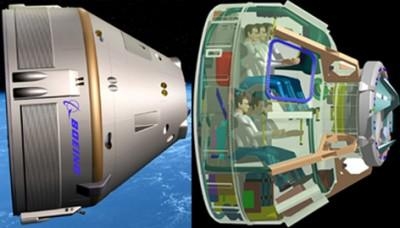Thu, Jun 28, 2012
CST-100 Attitude Control System Will Be Comprised Of Twenty-Four Of The Thrusters
A series of tests on a thruster destined for Boeing's Commercial Space Transportation spacecraft, designated CST-100, was completed recently by Pratt & Whitney Rocketdyne. Boeing is one of several companies working to develop crew transportation capabilities under the Commercial Crew Development Round 2 agreement with NASA's Commercial Crew Program.

Twenty-four thrusters will be part of the spacecraft's orbital maneuvering and attitude control system (OMAC), giving the CST-100 the ability to maneuver in space and during re-entry. The thrusters also will allow the spacecraft to separate from its launch vehicle if an abort becomes necessary during launch or ascent.
"Boeing and Pratt and Whitney Rocketdyne know what it takes to develop safe systems and subsystems," said NASA Commercial Crew Program Manager Ed Mango. "They're building on the successes of their past, while pushing the envelope with next-generation ideas to create a spacecraft for low Earth orbit transportation."
During tests conducted at the White Sands Space Harbor in Las Cruces, NM, an OMAC thruster was fired in a vacuum chamber that simulated a space-like environment of 100,000 feet. The tests verified the durability of the thrusters in extreme heat, evaluated the opening and closing of its valves and confirmed continuous combustion and performance. "We're excited about the performance of the engine during the testing and confident the OMAC thrusters will affordably meet operational needs for safe, reliable human spaceflight," said Terry Lorier, Pratt and Whitney Rocketdyne's Commercial Crew Development program manager.
All of NASA's industry partners, including Boeing, continue to meet their established milestones in developing commercial crew transportation capabilities.
NASA also is developing the Orion spacecraft and Space Launch System (SLS), a crew capsule and heavy-lift rocket that will provide an entirely new capability for human exploration beyond low Earth orbit. Designed to be flexible for launching spacecraft for crew and cargo missions, SLS and Orion will expand human presence beyond low Earth orbit and enable new missions of exploration across the solar system. (Image provided by Boeing)
More News
Airplane Bounced About 3 Ft Then Touched Back Down And Then, With No Brakes Applied, The Airplane Began Veering To The Left Analysis: The pilot entered the airport traffic pattern >[...]
Aero Linx: British Microlight Aircraft Association (BMAA) The primary focus within all aviation activity is SAFETY. In all aspects of our sport SAFETY must come first, whether it b>[...]
From SnF25 (YouTube Edition): William Wynne Builds Practical Aircraft Engines on the Corvair Platform Seeking an affordable alternative to the traditional aircraft engine options, >[...]
How To Get A Story On Aero-TV News/Feature Programming How do I submit a story idea or lead to Aero-TV? If you would like to submit a story idea or lead, please contact Jim Campbel>[...]
From 2023 (YouTube Edition): Bridge of CiES CiES Inc. is a Bend, Oregon-based designer and manufacturer of modular embedded aircraft systems and sensors. The company’s fuel-l>[...]
 NTSB Final Report: Aviat A1
NTSB Final Report: Aviat A1 ANN's Daily Aero-Linx (07.08.25)
ANN's Daily Aero-Linx (07.08.25) Classic Aero-TV: Fly Corvairs Reliable Engine Alternative
Classic Aero-TV: Fly Corvairs Reliable Engine Alternative ANN FAQ: Contributing To Aero-TV
ANN FAQ: Contributing To Aero-TV Classic Aero-TV: CiES Fuel-Quantity and e-Throttle Systems Praised
Classic Aero-TV: CiES Fuel-Quantity and e-Throttle Systems Praised



